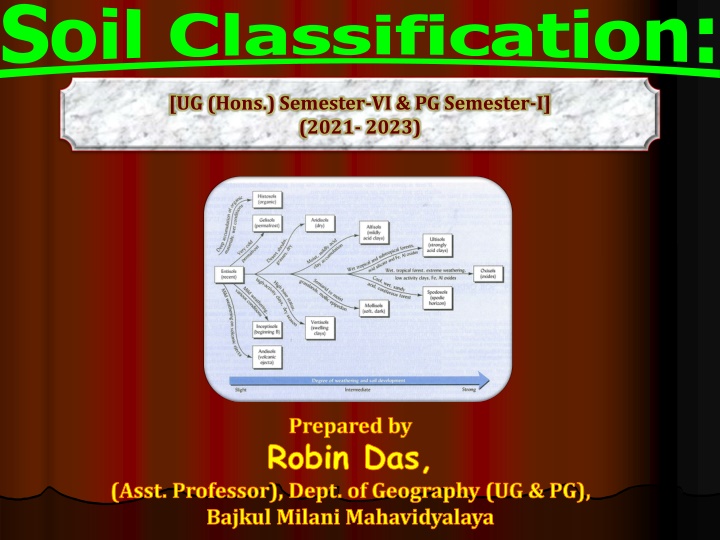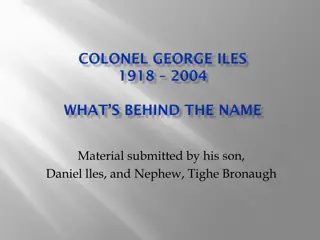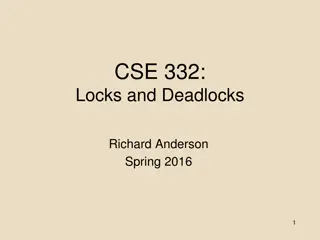
Soil Classification Systems and Taxonomy: Exploring Different Approaches
Discover the objectives, geological aspects, economic, physical, chemical, and biological classifications of soil. Delve into various soil classification systems such as Marbut's, Smith's, Joffey's, and more. Understand the significance of soil taxonomy methods like USDA, Russian, and UK methods, and the need for refinement in soil surveys. Prepared by Robin Das, Assistant Professor at Bajkul Milani Mahavidyalaya.
Download Presentation

Please find below an Image/Link to download the presentation.
The content on the website is provided AS IS for your information and personal use only. It may not be sold, licensed, or shared on other websites without obtaining consent from the author. If you encounter any issues during the download, it is possible that the publisher has removed the file from their server.
You are allowed to download the files provided on this website for personal or commercial use, subject to the condition that they are used lawfully. All files are the property of their respective owners.
The content on the website is provided AS IS for your information and personal use only. It may not be sold, licensed, or shared on other websites without obtaining consent from the author.
E N D
Presentation Transcript
Classification: [UG (Hons.) Semester-VI & PG Semester-I] (2021- 2023) Prepared by Robin Das, (Asst. Professor), Dept. of Geography (UG & PG), Bajkul Milani Mahavidyalaya
Objectives of Soil Classification Objectives of Soil Classification about Soil Characteristics / Co-existing Relations among Assessment of Relative and Expected Land use and Its Estimation of the Nature, Classification through Soil Fertility & Productivity of based on Soil Classification Organization of Soil and Development Programme Knowledge Achievement Conceptual Analysis of Determining the Land Soils related concepts Land use Planning & Present Land use & Simplification & different soils Soils properly Classification Attributes Principles Prepared by Robin Das
Classification: Soil Classification System Geological Approach: Soil Groups Sedimentary Groups Transported Groups Soil Groups Laterite & Lateritic Soils Red Soils Black Soils Delta Soils Desert Soils Tarai Soils Prepared by Robin Das
Classification: Soil Groups Economic Classification Physical Classification Chemical Classification Physiographic Classification Biological Classification Geological Classification Prepared by Robin Das
Soil Classification: Soil Classification Marbut s Classification Classification by Smith Classification (1879 & Joffey s Classification Classification (1951, Classification (1938) Baldwin, Kellogg & 1964/1967/1975) Soil Taxonomical Modified Genetic Thorp s Genetic & Thorp (1949) (1927 & 1935) Dokuchaiev s Approach & 1953-1960/ (1912) 1900) Prepared by Robin Das
Soil Taxonomy: USDA methods, Russian Methods, UK Methods & other older classification Necessity for correction & modification of all the weak and wrong points of those methods Soil Survey Staff of USA (G.D.Smith et.al.) (1951 1953-1960) 7-years, 7-stages & 7th Approximation Prepared by Robin Das
BASIC FEATURES OF SOIL CLASSIFICATION- 7TH APPROXIMATION 1. Natural classification of soil; 2.Based on properties of soil; 3.Preferable properties must be quantitatively observable or measurable; 4.Selected properties either affect soil genesis or result from soil genesis; 5.Properties with greater significance to plant growth should be selected for higher category; and 6.System is flexible. Prepared by Robin Das
Taxonomy: Classification, especially according to natural relationships. The systematic distinguishing, ordering and naming of type groups within a subject field. Soil Science Society of South Africa SOIL ORDERS Andisols - Volcanic Aridisols - Desert Gelisols - Frozen Histosols - Organic Vertisols Shrink Swell Inceptisols - Infant Entisols - Resistant Alfisols Moderately Weathered Ultisols Highly Weathered Oxisols - Tropical Spodosols - Flatwoods Mollisols - Prairies Nomenclature (names) are largely logical 12 orders: Alfisols Andisols (ando blacksoil) Aridisols (aridus dry) Entisols (recent) Gelisols (gelid very cold) Histosols (histos tissue) Inceptisols (inceptum beginning) Mollisols (mollis soft) Oxisols (oxide) Spodosols (spodos wood ash) Ultisols (ultimus last) Vertisols (verto turn)
The US System of Soil Taxonomy Two basic features:- 1. Based on soil properties that are easily verified and 2. The unique nomenclature system. The US System classification scheme contains 6 categories: 1. Order the most general grouping(based on soil forming processes) 2. Suborder - defined by moisture, temp, dominating chemical or textural features(climatic envt., vegetation & wetness) 3. Great Group - by differentiating horizons 4. Subgroup - three types: typical (typic), intergrade, not one of the other two 5. Family - plant growth or engineering properties(based on texture, mineralogy, temperature & soil depth). 6. Series common name, like yours and mine (based on kinds & arrangement of horizons). Prepared by Robin Das
In addition to these categories, we have the soil Phase (or soil Type), which refers to surface properties such as texture, thickness, slope, coarse fragments, salinity, erosion, etc. This is added to a series name (like Aiken clay loam, eroded phase). 1. Order (11), 2. Sub-Order (60-47), 3. Great Group (225-230), 4. Sub-Group ( 1000-only in USA-1200), 5. Family, (5000 only in USA-6600) 6. Series (12000-only in USA-16,800) and 7. Phase or Type Prepared by Robin Das
SOIL ORDERS (12 major units of classification according to the US 10th Approximation) Alfisols: Relatively high base saturation; not organic rich; evidence of clay transport. Andisols: Soils derived major properties from volcanic parent material. High P fixation. Aridisol Aridisols: Arid soils; Low in organic matter; high in salts and pH. Entisols: Leftovers; Not well-developed even after long periods (can occur anywhere) Prepared by Robin Das Entisol
Gelisols: permafrost. Histosols: Soils formed from organic matter (peats and mucks). Inceptisols: Still forming; Water is available for soil formation (e.g., glaciated soils). Mollisols: Brown-black surface horizons; High in organic matter, vermiculite or smectite clays; Base saturation usually > 50% (e.g., Iowa farm soils) Most extensive in the US (25%). Gelisol Histosol Inceptisol Mollisol Prepared by Robin Das
Oxisols: Highly-weathered; Only quartz, kaolinite, and Fe and Al oxides left (e.g., tropical rainforest). Spodosols: Evidence of Fe, Al, and organic matter transport; Often a whitish E Horizon (e.g., boreal forest). Ultisols: Clay transport like Alfisols, but much more acidic. Higher temperature; Often highly weathered (e.g., Southeastern U.S.). Vertisols: Mixed soils; Swelling clays, frost, etc cause lower horizons to mix with upper horizons; Often characterized by cracks. Oxisol Spodosol Prepared by Robin Das
MERITS 1. Comprehensive system & considerable amount of care in the nomenclature of soil; 2. Emphasis on physical & chemical characteristics; 3. Used French, Latin & Greek words reflects the characteristics of soil; 4. Scope to include new soils is easy; 5. Idea of soil classification, not any related science. DEMERITS 1. Deviated from genetic system of classification; 2. No geographical limits (vertisol, entisol, inceptisol and histosol); 3. No soil order for saline and hydromorphic soil; 4. Different modes of origin have been unduly included in the same group. Prepared by Robin Das
THANK YOU Prepared by Robin Das, (Asst. Professor), Dept. of Geography (UG & PG), Bajkul Milani Mahavidyalaya








